Kolkata is known as the city of joy. But what if, we tell you that it doesn’t lack elements of being the city of wonders as well! The pursuit of inventiveness this time took ‘The Creative Post’ to a little piece of Japan residing in Kolkata under the shade of Buddhism.
You don’t have to be a preacher or a worshiper to adhere inner peace. Just single out a day from your daily life and visit to ‘Nipponzan Myohoji’, a Japanese Buddhist temple in Kolkata. This unnoticed Japanese Buddhist temple is a respite from the bustle of Kolkata.
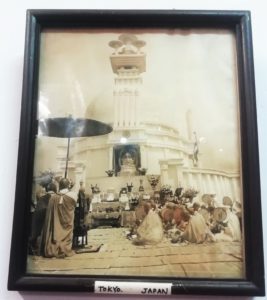 Traced back to the late 1930s, this monastery hosts a few followers of Nipponzan Myohoji, a pacifist Japanese religious movement. It’s a comparatively new movement—it only ascended in the early to mid-1920s— and originates from a 13th-century branch of Buddhism named Nichiren Buddhism.
Traced back to the late 1930s, this monastery hosts a few followers of Nipponzan Myohoji, a pacifist Japanese religious movement. It’s a comparatively new movement—it only ascended in the early to mid-1920s— and originates from a 13th-century branch of Buddhism named Nichiren Buddhism.
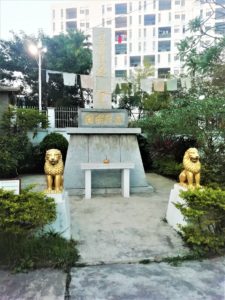
In Kolkata, their white temple is a place for silent reflection and contemplation. It’s a beautiful spot, where the strain of the city seems to dissolve away. The compound houses, a white construction comprising statues of the Buddha as well as a pillar with two lions adjoining it. Behind the temple are small quarters where a few devotees and the head monk stay. The Japanese Buddhist Temple consists of a two-tiered milk white structure with golden boarders and is crowned with a stupa.
There is an extended portico and a small flight of stairs leads to the interior of the temple. The garden consists of a beautiful pillar with beautiful Japanese calligraphy in bright golden colour. It probably carries a message of peace. The pillar is guarded by a pair of golden lions.
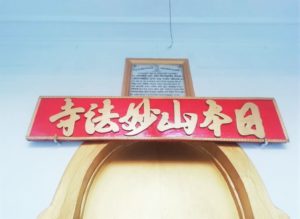 When you enter the peaceful temple, you’ll likely hear chants of “Na – Mu – Myo – Ho – Ren – Ge – Kyo.” The chant is also written in some places on the temple itself. Visitors from miscellaneous backgrounds are welcome to join in the prayers, which happens daily twice; at 5 am – 6:00 am. and 5 pm – 6:00 pm. The monks, open to interested visitors, often answer questions one might have.
When you enter the peaceful temple, you’ll likely hear chants of “Na – Mu – Myo – Ho – Ren – Ge – Kyo.” The chant is also written in some places on the temple itself. Visitors from miscellaneous backgrounds are welcome to join in the prayers, which happens daily twice; at 5 am – 6:00 am. and 5 pm – 6:00 pm. The monks, open to interested visitors, often answer questions one might have.
The Nipponzan Myohoji, was founded by Japanese monk Nichidatsu Fuji (1885-1985). Nichidatsu Fujii was a disciple of the great Japanese Buddhist monk Nichiren, who held the opinion of Lotus Sutra.
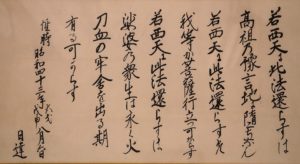
The Japanese Buddhist Temple is located on the Lake Road, now known as Kabi Bharati Sarani, in Dhakuria area of South Kolkata. Sadly, its presence is unknown to most Kolkatans.
If you are approaching the temple from the north (Golpark) side, it is best not to take the Dhakuria Bridge (now known as Sri Chaitanya Mahaprbhu Bridge) but to take the side road which goes past the AMRI Hospital.
Now, what is Lotus sutra?
The Lotus Sūtra (Sanskrit: Saddharma Puṇḍarīka Sūtra, literally “Sūtra on the White Lotus of the Sublime Dharma”) is one of the most popular and influential Mahayana sutras, and the basis on which the Tiantai, Tendai, Cheontae, and Nichiren schools of Buddhism were established.
According to British professor Paul Williams, “For many East Asian Buddhists since early times, the Lotus Sutra contains the final teaching of the Buddha, complete and sufficient for salvation.”
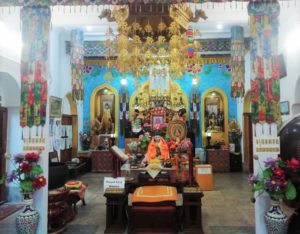 The moment you will step into the temple premise, you will feel peace and quietude all around. And you would find a very important person if you had eyes for it.
The moment you will step into the temple premise, you will feel peace and quietude all around. And you would find a very important person if you had eyes for it.
Apart from the Gurus and monks present their, we met Ritam Das. A little boy from the nearby Dhakuria slum who attends the prayers twice every day. He studies in 4th standard and alongside the studies and other daily activities he spends his leisure at this Japanese Buddhist Temple.
Do you come here often?
“Yes, after coming back from school I come here. I assist Guruji in preparing the temple for the daily prayer. Mostly, I come during the evening time. I do the sitting arrangements and distribute the prashad (a devotional offering made to a god, typically consisting of food that is later shared among devotees).”
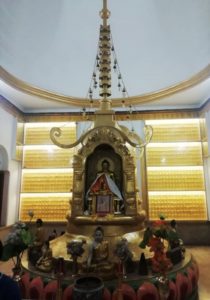 Instead of playing with other kids, why do you choose to come here?
Instead of playing with other kids, why do you choose to come here?
“I feel good here. I can be on my own here. The slum is often in chaos; but here it is very peaceful. And Guruji loves me. He tells me the stories of this temple too. I like hearing about the history of it.”
Well, can you tell us those stories?
“The picture you see is our Maha-Guru (the founder), Nichidatsu Fuji. He used to sit in this chair and do the daily chanting of Lotus sutra. At the entrance of the temple is a small signage, which reads “Na – Mu – Myo – Ho – Ren – Ge – Kyo”, translated it means “I take refuge in the wonderful law of the Lotus Flower Sutra.””
From the ceiling hung beautiful lamp shades and the walls are dotted with scrolls with beautiful flowing Japanese calligraphy. Also, on the walls hang a photograph of Nichidatsu Fujii, the founder of the temple.
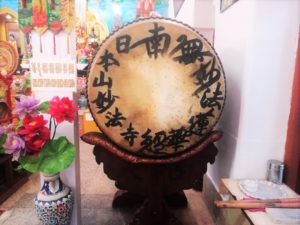
I was startled hearing this little guy. He was talking like a little Guru. He pointed at the big drum and said –
“Guruji beats that drum while chanting mantras. He said that the drum is a symbol of the rhythm in our lives. Sometimes, I play that too during the Budhha-purnima rituals. (a Buddhist festival that marks Gautama Buddha’s birth, enlightenment and death)”
Buddhism encourages its people to avoid self-indulgence as well as self-denial. Buddha’s most important teachings, known as “The Four Noble Truths”, are essential to understanding the spiritual path. Buddhists embrace the concepts of karma (the law of cause and effect) and reincarnation (the continuous cycle of rebirth).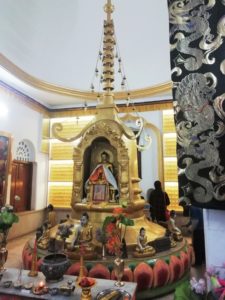
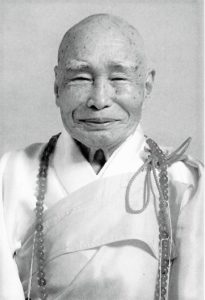 Understanding Ritam’s words, it could be said that Nichidatsu Fuji, the founder of Nipponzan Myohoji, was a disciple of Nichiren; who was a Japanese Buddhist priest of the Kamakura period. He developed the teachings of Nichiren Buddhism, a branch school of Mahayana Buddhism. Nichiren declared that the Lotus Sutra alone contains the highest truth of Buddhist teachings suited for the Third Age of Buddhism. Nichiren Buddhism differs from other schools of Buddhism in focusing on this world, and in its view that it is the only correct tradition. It also emphasizes the importance of individuals taking responsibility for improving themselves.
Understanding Ritam’s words, it could be said that Nichidatsu Fuji, the founder of Nipponzan Myohoji, was a disciple of Nichiren; who was a Japanese Buddhist priest of the Kamakura period. He developed the teachings of Nichiren Buddhism, a branch school of Mahayana Buddhism. Nichiren declared that the Lotus Sutra alone contains the highest truth of Buddhist teachings suited for the Third Age of Buddhism. Nichiren Buddhism differs from other schools of Buddhism in focusing on this world, and in its view that it is the only correct tradition. It also emphasizes the importance of individuals taking responsibility for improving themselves.
Although it can be seen as a highly self-focused religion, followers of Nichiren Buddhism believe that individual empowerment and inner transformation contribute, in turn, to a better and more peaceful world.
Our conversation was going on as Ritam was giving us a tour of the temple. Suddenly, we heard that drum playing. Ritam stopped us for a while and said – “The prayer has begun. You should go inside and take your seat. I have to assist Guruji now.”
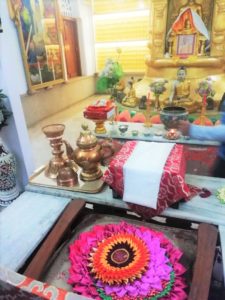
As we sat their witnessing the beautiful prayer ceremony, a feeling of serendipity acquired our entire inner self. People from various background came and sat in front of the idol of Budhha. Some were seen meditating during the holy ceremony. Some started chanting the mantras along with the Guruji. Ritam was busy showing them places to sit and accompany them to the ceremony from the entrance.
It was a surprise to see such a little soul in so much peace and happy state of mind. He started distributing the prasad with a happy face to every person leaving the temple at the end of the prayer.
We also stood up to leave and as I went to bid goodbye to my new little friend, he smiled and said – “You can visit us anytime you want. The door of Nipponzan Myohoji is open 24/7 for everyone”.
So, if you are looking for peace for a little time in your hectic daily life; do visit this Japanese Budhhist Temple. You will feel the calmness in the wind that surrounds the temple. No matter how tired you are; when you will leave this temple, you will come out as a rejuvenated human being.
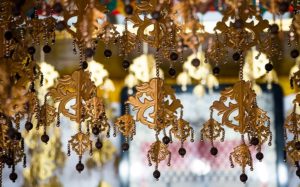

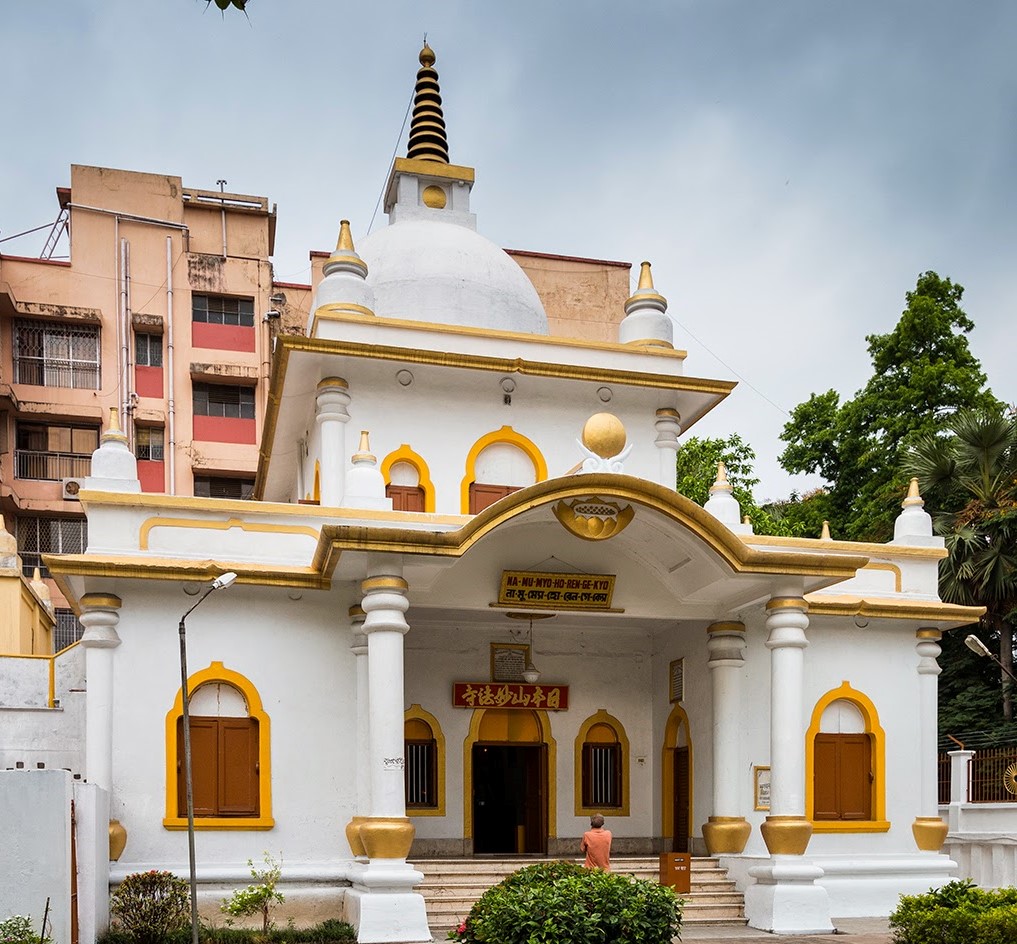
The East Indian Frugal Traveler can begin his journey right here among the historic lake.